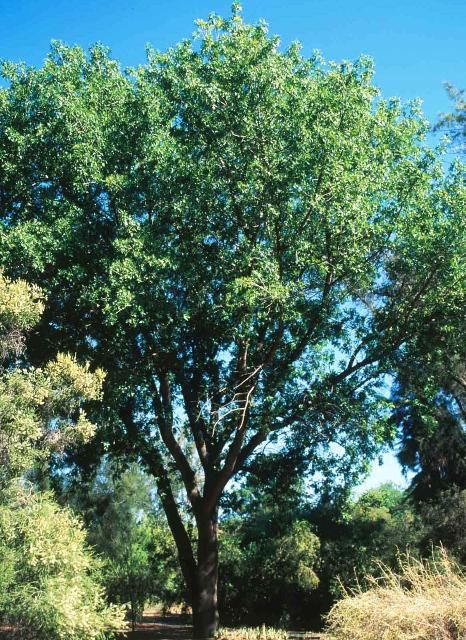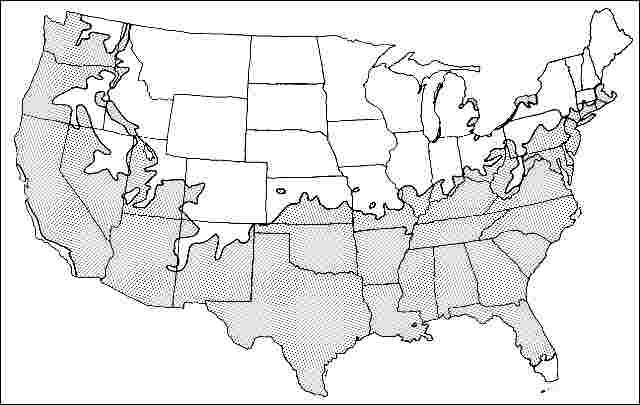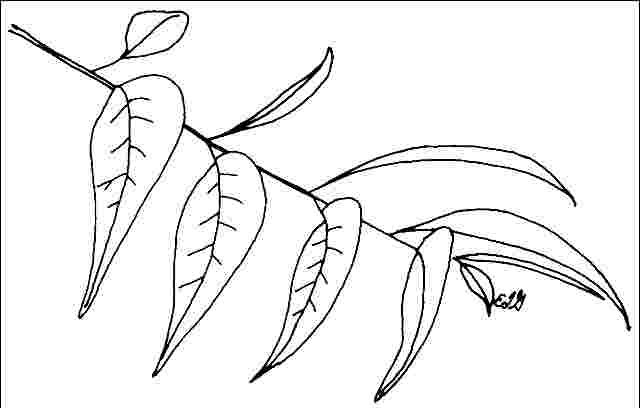Introduction
Western soapberry is native to central and western Texas and an excellent shade or ornamental tree, reaching 40 to 50 feet in height with an equal spread, forming a billowy, deciduous crown. The crown is usually quite open showing the trunk and some major limbs but this varies from tree to tree. Not a uniformly-shaped crown, some vase-shaped, others round. The medium green, glossy leaves have downy undersides and the leaves turn a beautiful, deep, yellow-gold hue in fall. The small, yellowish-white springtime blooms appear in 6- to 10-inch terminal panicles and are followed by translucent, yellow-orange, half-inch, grape-like, clustered fruits which persist through the fall, eventually ripening to black. The low-branching habit, furrowed, red-brown to grey-brown bark covering the strong, broad trunk, and clusters of translucent berries of Soapberry provides much winter interest when the branches are bare. The common name is derived from the fact that the fruits, when crushed in water, create great quantities of suds and were used by West Indian/Mexican natives as a laundry soap, floor wax, and varnish.

Credit: Ed Gilman, UF/IFAS
General Information
Scientific name: Sapindus drummondii
Pronunciation: SAP-in-dus drum-AWN-dee-eye
Common name(s): Western soapberry
Family: Sapindaceae
USDA hardiness zones: 6A through 9B (Fig. 2)
Origin: native to North America
Invasive potential: weedy native
Uses: tree lawn 4-6 feet wide; tree lawn > 6 ft wide; sidewalk cutout (tree pit); reclamation; street without sidewalk; specimen; shade; urban tolerant; highway median
Availability: somewhat available, may have to go out of the region to find the tree

Description
Height: 40 to 50 feet
Spread: 40 to 50 feet
Crown uniformity: symmetrical
Crown shape: round, vase
Crown density: open
Growth rate: moderate
Texture: medium
Foliage
Leaf arrangement: alternate (Fig. 3)
Leaf type: even-pinnately compound
Leaf margin: entire
Leaf shape: lanceolate, oblong
Leaf venation: pinnate
Leaf type and persistence: deciduous
Leaf blade length: less than 2 inches, 2 to 4 inches
Leaf color: green
Fall color: yellow
Fall characteristic: showy

Flower
Flower color: yellow, white/cream/gray
Flower characteristics: showy
Fruit
Fruit shape: round
Fruit length: less than .5 inch, .5 to 1 inch
Fruit covering: dry or hard
Fruit color: black, yellow, orange
Fruit characteristics: attracts birds; showy; fruit/leaves a litter problem
Trunk and Branches
Trunk/bark/branches: branches don't droop; showy; typically one trunk; thorns
Pruning requirement: little required
Breakage: resistant
Current year twig color: brown, gray
Current year twig thickness: medium
Wood specific gravity: unknown
Culture
Light requirement: full sun, partial sun, or partial shade
Soil tolerances: clay; sand; loam; alkaline; acidic; well-drained
Drought tolerance: high
Aerosol salt tolerance: none
Other
Roots: not a problem
Winter interest: yes
Outstanding tree: yes
Ozone sensitivity: unknown
Verticillium wilt susceptibility: unknown
Pest resistance: resistant to pests/diseases
Use and Management
Fruit maintains showy orange-yellow color on the tree throughout the winter. Fruit drops while it is firm and does not rot to create a mess but people could roll on it and fall on a sidewalk. The abundant fruits may create an unwelcome invasion of seedling volunteers. Plant it in a lawn area where regular mowings prevent seedlings from developing. Due to the risk of dermatitis and possible poisoning from the fruit, use Western soapberry as an ornamental or median-strip street tree away from where children would regularly contact the fruit.
A North American native, western soapberry grows in full sun or partial shade on a wide variety of soils. The crown is much denser in full-day sun. Western soapberry is particularly well-suited to urban conditions, tolerating wind, drought, and infertile soils with ease. Transplants easily and establishes with only minimal irrigation. The close-grained, strong wood makes this tree very resistant to wind damage and adaptable to urban landscapes. Excellent for poor, compacted or alkaline soil. Root suckers can be a problem in sandy soil but apparently not in clay.
There may be a fruitless cultivar originating in Oklahoma which would make it suitable for a much broader usage including downtown streets and patios.
Propagation is by seed or hardwood cuttings. Seedlings transplant easily.
Pests and Diseases
No pests or diseases of major concern although dwarf mistletoe can be quite a problem. One of a few plants apparently resistant to root rot. Powdery mildew, leaf spot and leaf blight have been reported in Texas but it is usually a pest-free tree.